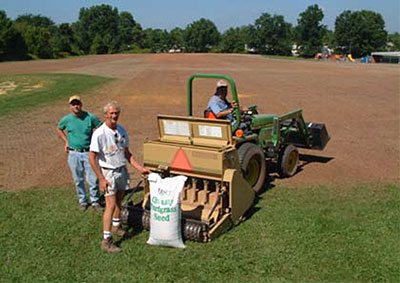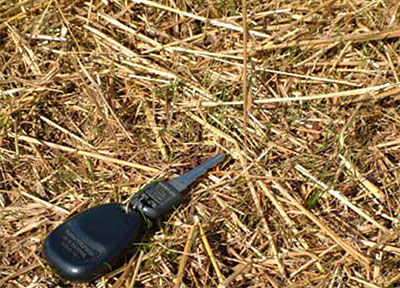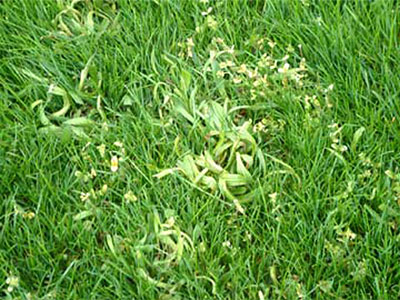Fact Sheet FS584
An attractive lawn with minimum maintenance problems begins with proper site preparation. The initial investment should be considered over the many years that a correctly established and maintained lawn will provide enjoyment. For example, improper grading can increase mowing time and reduce turf quality. Drainage problems will encourage weed encroachment and wetter areas are difficult to mow. Research studies have demonstrated that the rapid germination and growth of turfgrass is critical for a successful lawn establishment.
Listed below are the major points to consider when planting a new lawn:
Grading
Establish a sloping grade, free of depressions, away from buildings. Naturally wet areas, due to internal drainage problems, should be corrected by the installation of a subsurface drainage system such as perforated pipe and stone. Remove all rough debris including large stones. The grade around established trees should not be altered to avoid damaging the existing root system.
Soil Preparation
It is important to properly prepare the soil. The following steps should be accomplished prior to seeding:
- Soil Testing: Make every effort to have the soil tested. Test results will provide an accurate recommendation of the specific lime and nutrient requirements for that soil. County Cooperative Extension Offices can assist in obtaining the soil testing kits and in the interpretation of the results.
-
Liming: Proper liming is essential for maximum utilization of the applied fertilizer and other soil nutrients by the germinating turfgrass.
- Apply the recommended amount of lime and fertilizer and incorporate uniformly into the soil 4 to 6 inches deep.
- If the amount of lime required exceeds 200 pounds per 1000 square feet, apply one-half of the recommended amount, work it into the soil, then apply the remainder and incorporate into the soil.
- Soil Amendments: With very sandy or heavy (fine textured) clay soils, adding organic matter into the top 2 to 4 inches improves soil aeration and moisture holding capacity. Peat moss at 1 to 2 cubic yards per 1000 square feet is generally recommended. Other alternatives are well-rotted manure or leaf compost. If soil amendments are not economically feasible, select turfgrass varieties most adaptable to the specific soil conditions. Fine textured clay soils compact easily with grading and traffic. These soils should be tilled to establishment.
Fertilization
- Preplant Incorporated Fertilizer: Evenly broadcast fertilizer or other nutrient source as recommended by soil testing and till into the soil 3 to 4 inches deep. (Can be done with liming).
- Post Plant ("Topdress") Fertilizer: Following your incorporated application, a fertilizer should also be applied 2 to 4 weeks after turfgrass emergence. Apply 3 to 5 pounds of 20-10-10 fertilizer per 1000 square feet or the equivalent amount of 2-1-1 ratio fertilizer. Applying nitrogen containing fertilizer to young turfgrass seedlings promotes rapid lawn development. Consider watering in fertilizer if rain is not imminent. Do not apply fertilizer to "wet" grass seedlings as some types may cause plant "burn".
Seeding
-
Timing: Late summer and early fall provide the most ideal conditions for turfgrass establishment. Generally, this timing will allow adequate grass growth prior to winter. Cool evening and moderate daytime temperatures, along with anticipated fall precipitation, are conducive to rapid seed germination. In addition, many weeds including crabgrass are no longer germinating, reducing competition in new turfgrass plantings.
- Primary Establishment Period—late summer, early fall. (The earlier date is most desirable.) Southern New Jersey (Trenton and south) August 20 to October 10 Northern New Jersey (Trenton and north) August 15th to October 5th.
- Secondary Establishment Period—early spring (all of New Jersey).
- Establish the lawn during the first warm, dry period as soon as soil is dry enough to till without forming clods. Preparing soil when it is too wet results in poor germination and growth from compacted soil conditions.
-
Seed Selection: Many advances have been made by turfgrass breeders in recent years. For instance, there are now Kentucky bluegrass varieties better adapted to moderate shade, as well as improved disease resistance. Tall fescues, just a few years ago, were considered stemy, coarse grasses. Today, finer leafed, lower growing, denser and darker green tall fescues are available. The same can be said for perennial ryegrasses. Fine leaf fescues, such as hard fescue and creeping red fescue, are known for their adaptability to shady areas and "droughty" soil. New improved fine fescues are also available.

Use quality seed adapted to site.
In addition, the issue of seed mixtures is an important consideration. Reputable seed companies provide mixtures of "improved" varieties of various species allowing a wider range of site adaptation. Mixtures of various turfgrass species, each selected for a specific trait, provide the best opportunity for successful lawn establishment if a site has a combination of wet, dry, sunny and shady areas.
A brief description of the characteristics of the major species of lawn grasses is outlined below.- Kentucky Bluegrasses (Poa pratensis) This is a popular lawn grass in New Jersey. It is hardy, attractive, widely adapted and known for its pleasing color and leaf texture. New varieties have some shade tolerance and improved disease resistance. It is suitable for moderately to well-drained soil but is somewhat slow to establish from seed. Spreading underground rhizomes (stems) enhance recovery from injury and fill in voids. Seeding rate is approximately 2 pounds per 1000 square feet. Spring seedlings are difficult to establish.
- Tall Fescues (Festuca arundinacea) This is a coarser bunch-type grass able to persist in moderate to well-drained, infertile soils. Newer varieties are improved in leaf color, texture and density. Tall fescues are also known for rapid establishment from seed, excellent drought tolerance and ability to tolerate traffic. Seeding rates are 4 to 6 pounds per 1000 square feet.
- Fine Fescues (Festuca spp.) Fine fescues are comprised of several species (hard, sheeps, creeping red). As a group, they are known for their ability to persist in shady areas as well as in dry infertile locations. They establish slightly faster than Kentucky bluegrass. Improved newer varieties are useful for lower maintenance turfgrass areas. Fine fescues do not tolerate high traffic. Seeding rates are 4 to 6 pounds per 1000 square feet.
- Perennial Ryegrass (Lolium perenne) Breeding advances have produced varieties markedly improved over the older non-persistent types. These newer turf type ryegrasses have excellent color and fine textured leaves. They survive in a wide range of soil conditions but grow poorly in extremely wet areas. They possess moderate shade tolerance and very rapid establishment. Seeding rates are 4 to 6 pounds per 1000 square feet.
-
Seeding: The final seedbed preparation, seeding, and incorporation of the seed into the soil at the proper depth is critical. The areas should be raked to remove objectionable debris such as larger stones and clods of soil. Objects large enough to be struck by the mower blades (especially stones) should be the major focus of this effort. Smaller objects can be removed but they tend to settle into the soil over time. Seeding is ideally accomplished by the use of a "drop" spreader, however, a rotary "spinner" spreader can also be utilized. Seeding in two directions is preferable, applying one-half the recommended amount of seed in each direction.
The seed must be raked in approximately 1/4" deep and the area should be lightly rolled, but not overdone to cause compaction problems. (Rolling breaks clods, smoothes and improves seed-to-soil contact.) -
Other Considerations:
- Rapid Lawn Establishment: At certain times, such as in new home construction where dust or muddy conditions cause concern or on sloping terrain where soil erosion is a serious problem, a rapid cover of turfgrass is most critical. A first choice may be sodding the critical areas (see Rutgers Cooperative Extension fact sheet FS104, "Steps to an Instant Lawn"). Another choice can be the use of seed mixtures containing primarily perennial ryegrass or tall fescue. These varieties in combination with the use of straw mulch (see next point) and timely rainfall or irrigation can provide an "established" lawn in 4 weeks if growing conditions are favorable.
-
Straw Mulching and Irrigation: It is desirable to keep newly seeded lawns moist in the top 2 inches through irrigation or rainfall. If the top layer of soil dries out prior to good root establishment, poor stands of turfgrass may result. Some temporary surface drying is acceptable but should be kept to a minimum until germination is complete. Once seedlings have an established root system, watering can be less frequent and deeper (3 to 5 inches). Irrigation should not be overdone (do not create constant "muddy" conditions). Observe the drier areas of the lawn (sunny, high areas) for early signs of wilting. Irrigate, if feasible, to increase chances of successful establishment.

Clean straw mulch conserves moisture.
Straw mulch such as unrotted, weed seed free wheat, oat, rye, or salt hay can be applied at 50 to 90 lbs., (1 to 2 bales) per 1000 square feet. This offers a significant advantage for turfgrass establishment. Light mulching, where approximately 25% of the soil is visible through mulch, is all that is needed in most situations.
Mulching increases soil moisture retention. Morning dew is retained longer on the soil surface. Benefits include reduced watering needs and quicker seed germination.
In sloping areas and waterways where erosion is a consideration, heavier mulching is needed. To avoid smothering seedlings, partially remove mulch after germination occurs and 2–3 inch roots develop. In steep areas, erosion control matting with nylon netting or jute can also be applied over seeded areas and left in place after germination. These materials disintegrate over time and control soil erosion. -
Weed Control: Weed competition during the establishment period is one of the major reasons for lawn failures. This is especially true for spring seedings when many weeds germinate. Consider the application of herbicides to control broadleaf weeds and crabgrass (refer to Rutgers Cooperative Extension fact sheets FS385, "Broadleaf Weed Control in Cool Season Turfgrass", FS1308, "Crabgrass Control in Lawns for Homeowners in the Northern US", and FS1309, "Crabgrass and Goosegrass Identification and Control in Cool-Season Turfgrass for Professionals"). Use only herbicides which are labeled for NEWLY SEEDED lawns and follow label directions. Consider hiring a reputable certified pesticide applicator to avoid turfgrass injury from misapplied herbicides.

Weed control in newly planted turfgrass.
Acknowledgement
The author wishes to thank J. Heckman, R. Duell, R. Funk, J. Murphy, B. Clarke, and E. Milewski for their constructive inputs into this fact sheet.
February 2004
Copyright © 2024 Rutgers, The State University of New Jersey. All rights reserved.
For more information: njaes.rutgers.edu.
Cooperating Agencies: Rutgers, The State University of New Jersey, U.S. Department of Agriculture, and Boards of County Commissioners. Rutgers Cooperative Extension, a unit of the Rutgers New Jersey Agricultural Experiment Station, is an equal opportunity program provider and employer.

